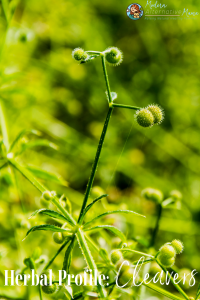By Sarena-Rae Santos, Natural Health Blogger
What are Cleavers?
Cleavers, also known as Goosegrass, Barweed, Catchweed, Clivers, Grip Grass, Sticky-willy, Zhu Yang Yang, and their scientific name Galium aparine, are a part of the Rubiaceae (Madder) family. Cleavers are native to Eurasia but naturalized in Australia, Greenland, and parts of South and North America (1). Cleavers can be identified by their narrow, sticky, and bristle-like leaves and stems. Additionally, cleavers have clusters of tiny, star-shaped white to greenish flowers and bare fruits (burrs) covered with hooked hairs that cling to animal fur and clothing (2).
Health Benefits of Cleavers
Some of the excellent medicinal benefits cleavers have been used for include:
Anti-Inflammatory Properties
Although inflammation is a natural bodily response, chronic inflammation can lead to detrimental health effects. Chronic inflammation has been linked with many diseases, such as type 2 diabetes, asthma, and certain cancers (3). Cleavers are widely known for their anti-inflammatory properties due to their diuretic effects. Even the mainstream recognizes cleaver’s ability to relieve swelling from edema and promote fluid movement throughout the body (4). Cleaver’s diuretic effects are also recognized by many herbalists and are deeply discussed in many herbal books (5).
Wound-Healing Properties
Cleavers are well known for their ability to promote wound healing. Cleavers have been used as a topical remedy for skin infections and wounds (6). This benefit is due to the stimulation of lymphocytes leading to increased production of reactive oxygen species (ROS) and cytokines. In other words, cleaver’s antioxidant activity can scavenge ROS protecting tissues from damage (7).
May Reduce Symptoms of Skin Conditions
Aside from their anti-inflammatory and wound-healing properties, cleavers benefit many skin conditions. According to one of my herbal books, cleavers are often taken for skin diseases such as seborrhea, eczema, and psoriases (8). One study review, which mentioned cleavers, concluded that herbs are rich sources of active ingredients and can be a safer and cost-effective method for managing skin ailments ranging from rashes to skin cancer (9).
May Promote Lymphatic Health
The lymphatic system is responsible for transporting hormones, fat, and fat-soluble vitamins; it’s even a huge part of our immune system (10). Unfortunately, in today’s world, environmental factors such as pollutants can cause sludge to hold up our lymphatic fluid resulting in congestion; that’s where cleavers come in. Herbalists note that cleavers increase lymphatic drainage and break up lymphatic congestion (enlarged lymph nodes), especially in the pelvis, which is generally a lymphatic tonic (11), and this is backed by science. One study noted that cleavers improve the function of the lymphatic and blood circulatory systems making them great for detoxification (12).
May Support Kidney & Bladder Health
The kidneys are most known for their responsibility to remove waste products and excess fluid from the body through urination to maintain a stable balance of its natural chemicals. This function is needed due to the importance of regulating the body’s salt, potassium, and acid content, all performed by the two kidneys (13). For some people, low urinary citrate is a risk factor for developing kidney stones (14).
Older literature highlights the similarities between the long cleaver’s stalk and the male urethra (15). Rosemary Gladstar and other herbalists note that cleavers tone and soothe irritations of the kidneys and urinary tract while promoting urination (16,17,18). Although I couldn’t find scientific research to back these claims, these benefits are recognized by mainstream urologists when discussing herbal mixtures offered to treat kidney and bladder problems, like bladder infections, kidney stones, and prostatitis (19).
Safety Concerns
Mainstream sources claim there isn’t enough reliable information to know if cleavers are safe or what the side effects might be when applied to the skin during pregnancy and breastfeeding. They recommend staying on the safe side and avoiding use. But they state it’s safe for most people when taken appropriately by mouth (20).
Contrarily, trusted herbalist Richard Whelan states there are no adverse reactions in the medical literature with cleavers. He also notes if needed, the herb can be used in strong doses for extended periods for all ages, including children and pregnant or breastfeeding women. As a soft caution, he suggests that, due to its cooling action, when someone from a cooler constitution is using this herb, they check that they are not going too far into the cold after being on it for a while, e.g., feeling more sensitive to the cold or more aggravated by it than usual (21).
How to Use Cleavers
You can find cleavers in dried bulk, pills, powders, teas, extracts, or tinctures. Tinctures always contain the most concentrated amount of herbs. Teas and soups are also options, especially when following Ayurvedic medicine recipes. Some great articles to check out featuring the use of cleavers include:
- Lymphatic Support Tincture
- 7 Ways to Naturally Balance Your Hormones
- Helping Your Lymphatic System (and Why it Matters)
Follow the recommendations of any supplement; some of my recommendations include:
- Earthley’s Lymphatic Cream is a lotion created to help relieve achy body parts caused by swollen lymph nodes. This cream tackles lymphatic congestion at the source and gently encourages drainage to help detox, reduce soreness, and improve overall wellness.
Disclaimer: This post is not intended as medical advice. These statements have not been evaluated by the FDA, and nothing in this post is intended to diagnose, treat, or cure anything. If you have questions, please do your own research or seek advice from a health professional.


